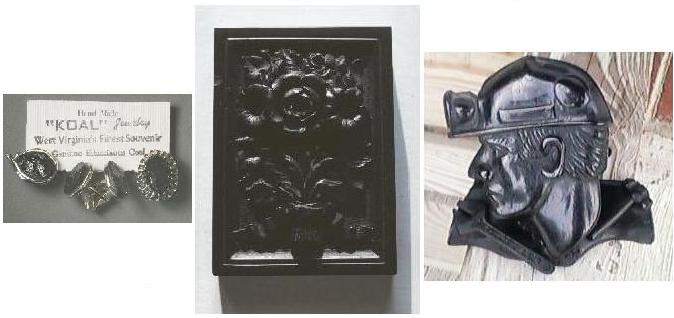( Fr-
charbon; Ger- Kohle;
Nor- kull; Rus- ![]() )
)
COAL (See also JET entry.)

A. Coal. "Koal" cuff links and ear rings (label indicates scale) from West Virginia. R.V. and F.S. Dietrich collection. (photo by Dick Dietrich)
B. Cannel coal carved plaque (height - ca.19 cm). C.T Holland collection. (photo by Dick Dietrich)
C. Coal carving by an unknown artist, probably from southeastern Kentucky. (photo courtesy of home.earthlink.net -- www.geocities.com)
DESCRIPTION: The nomenclature widely accepted for diverse
coals is based primarily on fixed carbon and ash contents
and whether the given coal will or will not coke. The following
properties
are oversimplified.
Color - black
H. 2-2½
S.G. 1.15-1.51
Light transmission - opaque
Luster - dull to vitreous to submetallic
Breakage - blocky
(some bituminous); choncoidal (some
anthracite); subconchoidal (some cannel coal);
etc.
Miscellaneous
- additional characteristics follow some of the names under
the next subheading.
OTHER NAMES: Although some coal strata (i.e.,seams or beds)
have been given formal stratigraphic names (see Appendix B, Glossary),
most are considered only members of larger units so their designations
differ from those of most stratigraphic units in two ways: The word
coal is not capitalized and the names are frequently indicated to be
"(informal)." Furthermore, the coal part of the term is
frequently
followed by the word member, seam or bed. Two examples are the Freeport
coal
(informal) of Pennsylvania and the Black Butte coal bed (informal) of
the Green River basin of Wyoming.
USES: The traditional giving of a piece coal as a New Year's gift -- to assure a warm hearth during the next year -- aside: In a response to a question about "early Inuit cultures in Alaska . . . (use of) coal, " archaeologist Stephen Loring notes that "Native Alaskans fashoined coal into labrets, or lip ornaments. . ." (Sithsonian 1 Feb. 2013, p. 94). Anthracite and bituminous coal have been fashioned by coal miners the world over, for the most part as a hobby but also for sale (as a way to make a little extra money). Several articles including cups and saucers, stones for jewelry (including cameos), paperweights and replicas of miners' boots as well as the so-called "traditional coal sculptures" (animals, eagles, etc.) made by Vietnamese artisans grace the cases of collectors and museums. Cannel coal has been carved into such diverse things as snuff bottles and wall plaques. "Koal" articles, such as those shown in Figure A, are sold as souvenirs in West Virginia. Some cloisonné consists largely of compressed and indurated coal (dust?). I suspect that some of the jet pieces -- e.g., the mourning jewelry of the Victorian era -- were made from some coal rather than jet, which is lignite, a precursor of coal.
OCCURRENCES: As beds or seams -- i.e., strata and lenses -- in sedimentary sequences.
NOTEWORTHY LOCALITIES: Diverse coals from Pennsylvania (e.g., anthracite from mines in the vicinity of Wilkes Barre, Lucerne County) and eastern Kentucky, southwestern Virginia, and West Virginia have been used as noted under the USES subheading.
REMARKS: Etymology of the word coal is complicated and sources I have read indicate it unlikely that any consensus will ever be reached so far as discovering its true roots. Consequently, it seems best not even to try to summarize possibilities here. Anyone really interested might start by reading the account in the Oxford English Dictionary, athough I hasten to add that for me that account led to more questions than answers. .A particularly remarkable
piece,
carved from a single piece of anthracite carved by Charles Harold
Harner ([aka. Horner],1873-1967) during the mid 1930s, depicts several
aspects of the early days of anthracite coal mining in Trevorton,
Pennsylvania with great detail . This carving, which is "table-top size,"
includes such things as the mine opening, a loaded mine car being
pulled by a mule, a train on tracks of the Susquehanna Railroad, and a
lock on the Pennsylvania Canal whereby barges transported the coal to
Harrisburg. Additional
carvings of anthracite coal by Harner, are in George Walaitis' museum
in Frackville, Pennsylvania -- e.g., replicas of "the state capitol
building [that] took five years to complete" and "the Nurthumberland
County courthouse at Sunbury [that] took 3 1/2 years to
complete." In the article listing these pieces, it also is
noted that "Harner's trademark was that all of the carvings were made
from a single piece of anthracite patiently shaped with varying sizes
of pen knives, a hack saw blade and buffed with steel wool or
sandpaper." (Kraus, 1989).
SIMULANTS:
Coal dust plus resin - Some curios -- e.g., candles and statuettes -- have been molded, carved or sculpted from this material. - [Texture is recognizably different from that of any coal.].
REFERENCES: No general reference. Stutzer, 1940.
R.V. Dietrich © 2015
Last
update: 10 March 2013
web page created by Emmett Mason